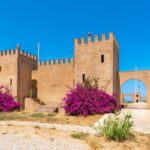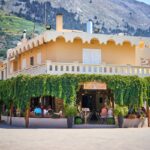Nestled in the heart of the Cycladic islands, Mykonos is Greece’s answer to Ibiza, attracting travellers from around the world with its stunning natural beauty, vibrant party scene, and rich cultural heritage.
Known for its iconic cube-shaped buildings and whitewashed exteriors, Mykonos offers visitors a unique blend of traditional charm and modern sophistication.
During the daytime, visitors can bask under the sun on the picturesque beaches, explore the island’s historic windmills, or take leisurely strolls through Hora’s charming narrow streets.
As the sun sets, Mykonos transforms into a bustling hub of activity, with its superclubs drawing partygoers and its bustling harbour offering awe-inspiring views.
Whether it’s your first visit to Mykonos or you’re a returning traveller, this guide will help you make the most of your stay on this enchanting Greek island.
With expert tips on the best attractions, places to stay, and local cuisine, get ready to embark on an unforgettable adventure in Mykonos.
The Best Time to Visit Mykonos
Weather Considerations
The best time to visit Mykonos, a stunning island in the Aegean Sea, is typically during September and October. During these months, the climate is still favourable for enjoying the beaches and exploring the island but without the peak-season crowds experienced in July and August.
Tourists can make the most of the pleasant weather, with daytime temperatures more than 30C in June, July, August and September.
For those seeking more mild, sunny weather and opportunities for activities like hiking or wine tasting, the months of May and October are recommended, as the temperatures are less intense and perfect for outdoor activities.
Festivals and Events
While Mykonos is widely known for its exciting nightlife and party atmosphere, it also plays host to a variety of local festivals and events. By visiting at the right time, you can experience this lively island’s cultural side:
- Easter celebrations: Greek Easter is a significant time in Greece, and Mykonos is no exception. Festivities include processions, fireworks, and traditional foods. Though the date varies each year, it typically falls in April or May.
- XLSIOR Mykonos: This annual international LGBTQ+ festival takes place in August. Participants can enjoy a week of music, parties, and events at various locations around the island.
- Mykonos Summer Festival: Attracting musicians, dancers, and actors, this event occurs during July and August. It offers a diverse array of street performances and artistic events.
By planning your visit around Mykonos’ weather and noteworthy events, you’re sure to have a memorable and enjoyable trip to this remarkable Greek island.
Top Attractions to Explore
Mykonos is a fantastic destination with plenty of attractions to explore. In this guide, we’ll highlight some of the top places to visit, including beautiful beaches, historic sites, and charming villages.
Beautiful Beaches
Mykonos is known for its stunning beaches, which offer various activities such as sunbathing, snorkelling and partying. Some of the island’s most popular beaches are:
- Paradise Beach: A lively beach known for its world-famous beach bars and clubs, great for dancing and enjoying the vibrant atmosphere.
- Super Paradise Beach: Another party hotspot that boasts crystal clear waters and golden sand, frequented by a diverse crowd.
- Platis Gialias Beach: A family-friendly beach with shallow waters and many facilities, perfect for a more relaxed beach experience.
Historic Sites
The island of Mykonos has a rich history that can be discovered through some of its most iconic landmarks. Don’t miss visiting:
- Windmills: One of the most recognisable symbols of Mykonos, this group of seven windmills overlooks the Hora harbour. Climb up the hill for a fantastic view of the island and its beautiful sunsets.
- Archaeological Museum of Mykonos: This museum houses ancient artefacts and provides valuable insights into Mykonos’ past. A worthy visit for history buffs!
- Armenistis Lighthouse: A testimony to Mykonos’ maritime past, this lighthouse stands guard over the waters between Mykonos and the neighbouring island of Tinos.
Charming Villages
Mykonos is home to picturesque villages with narrow streets, white houses, and vibrant local life. Some must-visit villages include:
- Hora: The island’s capital boasts labyrinth-like streets, a beautiful waterfront area, and the vibrant Mavrogenous Street, filled with art galleries and shops.
- Little Venice: A district in Hora known for its colourful houses and charming atmosphere, perfect for casual shopping, dining, or simply taking in the picturesque views.
- Ano Mera: A traditional village located in the centre of the island, offering a more authentic experience away from the hustle and bustle of the more touristy areas.
Local Cuisine and Nightlife
Gourmet Greek Food
Mykonos boasts an impressive selection of gourmet Greek cuisine, with an emphasis on fresh seafood and locally sourced ingredients. Olive oil, olives, and the unique Greek spice “throubi” feature prominently in many dishes.
Some popular and delicious options to try include:
- Mykonos sausages: These high-quality sausages are seasoned with throubi, salt, oregano, and pepper and air-dried. They have a higher lean meat content than fat, making them a favourite amongst locals and visitors alike.
- Grilled seafood: Freshly caught daily from the surrounding Aegean Sea, seafood dishes in Mykonos are a must-try. Specialities include grilled octopus, calamari, and fish, often served with a drizzle of olive oil and a side of Greek salad.
- Local cheese: Sample traditional cheeses like “kopanisti” (a soft, creamy, spicy cheese) and “tyrovolia” (a mild, fresh cheese).
Bars and Clubs
Mykonos is also well-known for its vibrant nightlife, offering a variety of options for every preference. From trendy open-air cocktail bars to lively nightclubs, there’s something for everyone.
Some top nightlife spots include:
- Open-air cinema: Hóra, the island’s capital, hosts an open-air cinema, offering a unique and enjoyable movie-watching experience.
- Beach bars: During the warm months, the island’s stunning beaches come alive with bars and clubs playing music well into the night. Enjoy breathtaking sunset views over signature cocktails at these venues.
- Nightclubs: Dance the night away at one of Mykonos’ many nightclubs, which often feature internationally renowned DJs and a lively atmosphere.
When planning your visit, keep in mind that peak travel times are between June and September, when hotels, beaches, restaurants, and clubs are at their busiest and most expensive. However, the shoulder season (April to early June, late September, and October) can offer a more relaxed experience, with fewer crowds and lower accommodation prices, while still taking in the vibrant local cuisine and nightlife.
Travel Tips and Safety
Transportation Options
Mykonos offers various transportation options to explore the island. Some popular choices include:
- Public buses: A cost-effective and efficient way to move around the island. They connect popular destinations such as Mykonos town, Platis Gialos, Psarou, and Super Paradise Beach.
- Taxis: Convenient, but can be more expensive, especially during peak season. Make sure to agree on a fare before starting the journey.
- Renting a vehicle: Scooters, ATVs, and cars are available for rent, allowing more flexibility to explore offbeat locations. It’s essential to carry an international driver’s licence and be mindful of local traffic rules.
Money Matters
When visiting Mykonos, it’s crucial to know how to manage money:
- Currency: Euro (€) is the official currency of Greece.
- ATMs and banks: ATMs are available throughout the island, and banks often provide currency exchange services.
- Credit and debit cards: Most hotels, restaurants, and shops accept credit and debit cards, but carrying some cash is advisable for smaller businesses and transportation.
- Tipping: A tip of around 10% is appreciated at restaurants, although not mandatory.
Health and Safety Precautions
While Mykonos is generally safe, it’s essential to take some precautions for a trouble-free vacation:
- Sun protection: Always wear sunscreen, sunglasses, and a hat when exposed to sunlight for a long period as the sun can be quite strong.
- Water safety: When visiting beaches, be cautious of strong winds and waves, particularly during the Meltemi season (July and August). It’s also a good idea to follow lifeguard advice when available.
- Nightlife safety: Mykonos is famous for its nightlife; however, it’s vital to stay aware of your surroundings, keep an eye on your belongings, and drink responsibly.
- Healthcare: While the island has a local hospital and a few pharmacies, it’s advisable to bring essential medications and a small first-aid kit. Also, to stay hydrated and prevent heat-related illnesses by drinking enough water.
Follow these helpful travel tips and safety precautions to make the most of your visit to the beautiful island of Mykonos.
Frequently Asked Questions
When is the best time to visit Mykonos?
The best time to visit Mykonos is during the shoulder seasons of spring (April to June) and autumn (September to October), when the weather is warm, and the island is less crowded. During these months, you can expect temperatures averaging in the upper 20s°C. July and August are also popular months for visitors, with temperatures averaging in the upper 20s°C, but the island can be quite busy during this peak season.
What are the top attraction on Mykonos?
Mykonos is known for its beautiful beaches, historic landmarks, and vibrant nightlife. Some top attractions include:
- Little Venice, a picturesque waterfront area with charming buildings and stunning sunset views
- The iconic windmills of Kato Mili, a symbol of the island’s past
- The ancient archaeological site of Delos, a UNESCO World Heritage site just a short boat ride away
- The Panagia Paraportiani, a 15th-century church and architectural marvel
- The idyllic beach resorts of Ornos, Platis Gialos, and Paradise Beach
What’s the best way to get around Mykonos?
Mykonos is a relatively small island, and there are several ways to get around. The island’s public bus system is an affordable and convenient option for travel to many popular destinations. Taxis are also available but can be limited during peak times. For more flexibility, renting a car, scooter, or ATV is a popular choice for visitors, allowing you to explore the island at your own pace.
What are your accommodation options on Mykonos?
Mykonos offers a wide range of accommodation options to suit any budget or preference. You can choose from luxury hotels and resorts, charming boutique hotels, traditional guesthouses, and even budget-friendly hostels. Popular areas to stay include Mykonos Town, Ornos, and Platis Gialos, which offer easy access to attractions, restaurants, and nightlife.
Where are Mykonos’ nightlife hotspots?
Mykonos is renowned for its vibrant nightlife, with a wide variety of bars, clubs, and beach parties to choose from. Some well-known nightlife spots include:
- Cavo Paradiso, a cliffside club featuring world-famous DJs and a spectacular view
- Skandinavian Bar, a popular meeting place with a lively atmosphere
- Tropicana Beach Club, a daytime beach party that continues well into the night
- Astra Bar, an upscale lounge with a chic ambiance and an elegant crowd
What are the best food recommendations in Mykonos?
Mykonos offers a delicious selection of Greek and Mediterranean cuisine. Traditional dishes you should try include:
- Souvlaki, skewered marinated meat served in pita bread with tzatziki sauce
- Saganaki, a fried cheese appetizer served with lemon
- Moussaka, a hearty baked dish of eggplant, potatoes, and minced meat with a creamy béchamel sauce
- Louza, a local cured meat similar to prosciutto
- Baklava, a sweet dessert made with layers of pastry, nuts, and honey syrup
Look for authentic Greek tavernas and local restaurants to try these dishes and experience the true flavours of Mykonos.

Born and raised on the sun-drenched island of Crete, Sofia Mavromatis is a seasoned traveler and writer with a deep-rooted love for Greece’s vibrant culture, stunning landscapes, and rich history.



